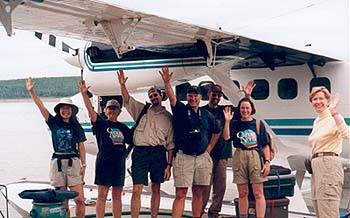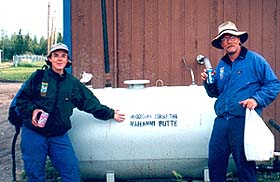Jeff and Debbie's
1999 Nahanni Canoe Trip
Back to menu
Final Comments

*
If you enjoyed this report, please do let me know! *
An absolutely wonderful trip. We had paddled nearly 400 kilometers, climbed mountains,
ran rapids, floated through canyons.
I had no whitewater experience and limited canoe trip experience (had been on two
very short trips) but enjoyed the experience thoroughly. Doing the cata-canoe thing
for the first day of rapids helped a lot in terms of building my confidence and
becoming semi-familiar with whitewater techniques.
Being used to working on my own all day, I had initially been worried about the group dynamics
and the lack of privacy. Although it would have been nice to have a little more
"downtime" to relax on one's own, I never found the conditions to be too crowded. In fact, I found myself enjoying the social aspect much more than
I had expected; it greatly enhanced the whole experience for me.
Some of my friends gave me strange looks when I first told them about my upcoming
trip. "Who's making you do this?" they would ask, or "You're PAYING to do this?"
I can see their point, in a certain sense. Why pay all this money to go through all
this physical hardship, using a hole in the ground as a latrine, shivering through
cold nights, facing the dangers of whitewater, potentially getting rained on all day
without shelter, watching out for grizzlies, and so on?
I found, however, that there's something to be said for pushing oneself to one's limit.
And past. There were times when I was so tired and cold and wet that I felt like throwing
my paddle away and running back to civilization, when I thought longingly of hot showers
and my own warm, dry bed at home. Times when my sore paddling muscles begged for a break, or I was so exhausted that I felt I couldn't take another
step up a mountain. But of course I did take another step, and another...amazing myself
as I did so, that it was possible to push that envelope a little further each time.
Surrounded by technological conveniences of all kinds, I think some of us tend to get
too used to having our needs instantly gratified and as a result get too stressed out
about little things ("What do you MEAN, I have to wait fifteen minutes for my steak?
This is outrageous! I'm leaving!").
The experience was also a complete mental vacation for me, putting me in a headspace
where it was impossible to worry about e-mail and work, where basics like finding warmth and shelter (as well as surviving the next rapid! :-)) took priority. I woke up every morning with
new sore muscles, but in an odd way I enjoyed the sensation...it reminded me I was alive,
and that being alive was Good. As Karen said in one of our issues of Nahanni News,
"another day on the right side of the grass". :-)
Some have already asked me whether I would do this trip again.
My answer? Absolutely.

Wildlife spotted during trip
- Black bears.
- Wolves.
- Sandhill cranes.
- Ducks.
- Loons.
- Moose and grizzly tracks.
- Dall sheep.
- Canada geese.
- Osprey.
- Rock ptarmigan.
- Snowshoe hares.
- Squirrels, chipmunks.
- Whiskey jacks (grey jays?).
- Frogs.
Advice for those considering this trip
Do some related reading! My personal recommendations:
Dangerous River by R.M. Patterson,
Nahanni: River of Gold, River of Dreams by Neil Hartling (it turned out he was on the river a day ahead of us),
Nahanni: The River Guide by Peter Jowett. A little more pricey but worth it for the spectacular photos is Nahanni Portfolio by Pat and Rosemarie Keough.
Be prepared for a wide range of conditions and temperatures. Some days were warm enough to wear a thin t-shirt and shorts. Nights tended to be cold, and on several mornings we woke up to find ice on our tent!
Get whitewater experience if at all possible.

Go with Nahanni Wilderness Adventures or Canoe North .
Dave Hibbard is amazingly knowledgeable about the Nahanni (this was his 39th trip on the river). Great food. Fun company. Well-organized. And the rapids were fun, even for someone like me with absolutely no whitewater experience. Although it can't be guaranteed for every trip, of course, I think it's significant that none of our canoes dumped even once in spite of widely varying paddling experience within the group.
THINGS I BROUGHT WHICH I'M VERY GLAD I BROUGHT:
- Hand cream, preferably water-resistant and containing glycerine. I liked Glysomed, which
was of a heavier texture than I usually used, but perfect for the canoe trip. The combination of water, silt, and sun resulted in all our
hands becoming chapped and callused by the end of the trip. The skin on my right thumb
split down the middle after the first week. The downside of using hand cream is that
it made my hands slip on the paddle; I got around this by using paddling gloves.
- Paddling gloves.
- Toque. I ended up wearing this most nights once we hit Virginia Falls.
- Tilley hat. Found the double straps very useful, as well as the small pocket.
- River shorts, river pants. Dried very quickly!
- Headlamp and extra batteries. Wearing a headlamp at night enabled me to do things
with both hands instead of having to hold a flashlight with one. Very useful when
writing in my journal in the evenings, or packing/unpacking at night.
- Bandannas. These came in handy in so many different ways that I highly recommend
bringing at least two. Possible uses include sun protection, handkerchief, cleaning cloth,
cooling (one day when it was scorching outside, I soaked a bandanna and draped it
over my head under my hat), carrying small items, path marker.
- Sunglasses. Paddling for hours in the glare of the sun's reflection off the water
would have been painful otherwise.
- Insect repellent.
- Two rolls of toilet paper (toilet paper became a valued commodity by the end of the trip :-)).
- Neoprene socks. Kept my feet relatively warm even when they had to get wet. I wore
them inside my Teva sandals during cooler days.
- Iridium satellite phone. Okay, so maybe this wasn't an essential; the Iridium
people let us bring the phone on the trip as an experiment. :-) The guides liked the phone
so much that they ended up leaving their own emergency radio at the compound. With
an extra battery, we had about three hours' talk time. Most of us made one call home
during the trip, mainly to let loved ones know we were okay, and the phone also came
in handy when confirming float plane pick-ups. With the accompanying pager, we were also able to
receive very brief e-mails although we couldn't send any. We kept the phone turned
off most of the time, but it was good to know the emergency contact was available
if we needed it.
- Carabiners: big and small. We used them to hook
flashlights up in our tent, loose gear to barrels and backpacks while portaging,
zippers together on luggage, even a small thermometer to the zipper of my jacket.
Possibilities are endless.
THINGS I WISH I HAD BROUGHT (OR BROUGHT MORE OF):
- More hand cream.
- More mesh bags to separate clothing within my drybag (easier to organize).
- Mittens or other warm gloves.
- Scarf.
- Fleece jacket with a water resistant layer on top.
- Nail brush (doesn't take up much room, and regular scrubbing with a cloth
didn't keep your fingers and fingernails clean enough).
- Garbage bags, for spreading out on the tent floor on particularly
damp or muddy days.
- Extravagant soaps and lotions for use in the Yellowknife hotel
-after- the trip.
- Pens.
- A copy of R.M. Patterson's The Dangerous River.
THINGS I BROUGHT WHICH I NEVER USED:
- Novel.
- Knee pads. The canoes provided by our guides already had knee pads
attached to the bottoms of our canoes which worked wonderfully
(though they tended to hold water).
PHOTOGRAPHY
Bring lots of film. I used up six rolls of 40-exposure Advantex film
plus one 35-exposure disposable waterproof camera. I would have taken more,
but was leery about taking out my regular camera (a Canon ELF) when we were running rapids
and in the rain since it wasn't weather-resistant.
Make sure you find good
waterproof protection for your camera in case of canoe dumps and rain
...Pelican cases seem to be popular
among the serious photographers in our group (hardshell, waterproof cases).
You can find a selection at http://www.nrscatalog.com/.
To end this trip report, I'll include Dave's last words of advice to us in Yellowknife as we said our good-byes:
"Keep your paddle in the water!"

Back |
Main menu




